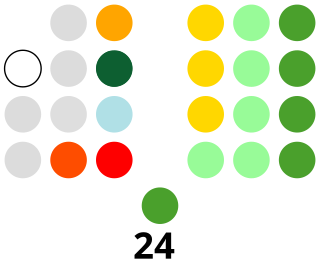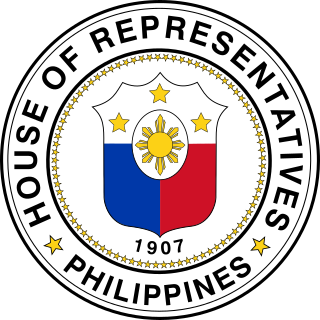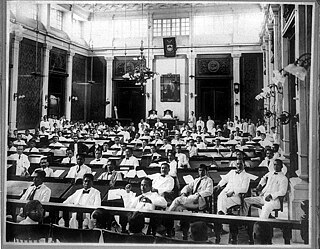
The Congress of the Philippines is the legislature of the national government of the Philippines. It is bicameral, composed of an upper body, the Senate, and a lower body, the House of Representatives, although colloquially, the term "Congress" commonly refers to just the latter. The Senate meets at the GSIS Building in Pasay, while the House of Representatives meets at the Batasang Pambansa in Quezon City, which also hosts joint sessions.

The House of Representatives of the Philippines is the lower house of Congress, the bicameral legislature of the Philippines, with the Senate of the Philippines as the upper house. The lower house is commonly referred to as Congress, although the term collectively refers to both houses.

The Senate of the Philippines is the upper house of Congress, the bicameral legislature of the Philippines, with the House of Representatives as the lower house. The Senate is composed of 24 senators who are elected at-large under a plurality-at-large voting system.
Elections in the Philippines are of several types. The president, vice-president, and the senators are elected for a six-year term, while the members of the House of Representatives, governors, vice-governors, members of the Sangguniang Panlalawigan, mayors, vice-mayors, members of the Sangguniang Panlungsod/members of the Sangguniang Bayan, barangay officials, and the members of the Sangguniang Kabataan are elected to serve for a three-year term.
The legislative districts of Abra are the representations of the province of Abra in the various national legislatures of the Philippines. The province is currently represented in the lower house of the Congress of the Philippines through its lone congressional district.

The legislative districts of Ilocos Norte are the representations of the province of Ilocos Norte in the various national legislatures of the Philippines. The province is currently represented in the lower house of the Congress of the Philippines through its first and second congressional districts.
The legislative districts of the Philippines are the divisions of the Philippines' provinces and cities for representation in the various legislative bodies. Congressional districts are for House of Representatives, while there are districts for Sangguniang Panlalawigan, and some Sangguniang Panlungsod. For purposes of representation, the Senate, most Sangguniang Panlungsod, Sangguniang Bayan, Sangguniang Barangay and Sangguniang Kabataan are all elected at-large, although there were districts for the Senate from 1916 to 1935.

The 4th Philippine Legislature was the meeting of the legislature of the Philippine Islands under the sovereign control of the United States from October 16, 1916, to March 8, 1919.
The 5th Philippine Legislature was the meeting of the legislature of the Philippines under the sovereign control of the United States from 1919 to 1922.
The 6th Philippine Legislature was the meeting of the legislature of the Philippines under the sovereign control of the United States from 1922 to 1925.
The elections for the Malolos Congress, also known as the Revolutionary Congress, were held in the Philippines from June 23 to September 10, 1898.
The elections for the members of the Philippine Assembly were held on June 6, 1916 pursuant to the Philippine Organic Act of 1902 which prescribed elections for every three years. After the passage of the Jones Law on August 29, 1916 in where the Philippine Assembly would be replaced by the House of Representatives of the Philippines or the Lower House, the elected members of the Philippine Assembly would be automatically members of the new House of Representatives.
The 15th Congress of the Philippines, composed of the Philippine Senate and House of Representatives, met from July 26, 2010, until June 6, 2013, during the first three years of Benigno Aquino III's presidency. The convening of the 15th Congress followed the 2010 general elections, which replaced half of the Senate membership and the entire membership of the House of Representatives.
Elections for the members of the House of Representatives were held on June 3, 1919 pursuant to the Philippine Organic Act of 1902, which prescribed elections for every three years. The ruling Nacionalista Party increased its majority from 75 seats out of 90 seats in the 1916 election to 83 out of 90 seats in this election.
Elections to the Philippine Legislature were held on June 6, 1922 pursuant to the Philippine Organic Act of 1902 which prescribed elections for every three years. Votes elected 90 members of the House of Representatives in the 1922 Philippine House of Representatives elections; and 24 members of the Senate in the 1922 Philippine Senate elections.
Elections to the Philippine Legislature were held on June 5, 1928 pursuant to the Philippine Organic Act of 1902 which prescribed elections for every three years. Votes elected 94 members of the House of Representatives in the 1928 Philippine House of Representatives elections; and 24 members of the Senate in the 1928 Philippine Senate elections.
Elections to the Philippine Legislature were held on June 2, 1925, pursuant to the Philippine Organic Act of 1902 which prescribed elections for every three years. Votes elected 90 members of the House of Representatives in the 1925 Philippine House of Representatives elections; and 24 members of the Senate in the 1925 Philippine Senate elections.
Elections to the Congress of the Philippines were held on May 11, 1987. Voters elected the members of Congress in the following elections:
The 17th Congress of the Philippines, composed of the Philippine Senate and House of Representatives, met from July 25, 2016, until June 4, 2019, during the first three years of Rodrigo Duterte's presidency. The convening of the 17th Congress followed the 2016 general elections, which replaced half of the Senate membership and the entire membership of the House of Representatives.
The 18th Congress of the Philippines, composed of the Philippine Senate and House of Representatives, met from July 22, 2019, until June 1, 2022, during the last three years of Rodrigo Duterte's presidency. The convening of the 18th Congress followed the 2019 general elections, which replaced half of the Senate membership and the entire membership of the House of Representatives.




